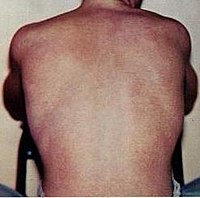
Photo from wikipedia
Background Larviciding against malaria vectors in Africa has been limited to indoor residual spraying and insecticide-treated nets, but is increasingly being considered by some countries as a complementary strategy. However,… Click to show full abstract
Background Larviciding against malaria vectors in Africa has been limited to indoor residual spraying and insecticide-treated nets, but is increasingly being considered by some countries as a complementary strategy. However, despite progress towards improved larvicides and new tools for mapping or treating mosquito-breeding sites, little is known about the optimal deployment strategies for larviciding in different transmission and seasonality settings. Methods A malaria transmission model, OpenMalaria, was used to simulate varying larviciding strategies and their impact on host-seeking mosquito densities, entomological inoculation rate (EIR) and malaria prevalence. Variations in coverage, duration, frequency, and timing of larviciding were simulated for three transmission intensities and four transmission seasonality profiles. Malaria transmission was assumed to follow rainfall with a lag of one month. Theoretical sub-Saharan African settings with Anopheles gambiae as the dominant vector were chosen to explore impact. Relative reduction compared to no larviciding was predicted for each indicator during the simulated larviciding period. Results Larviciding immediately reduced the predicted host-seeking mosquito densities and EIRs to a maximum that approached or exceeded the simulated coverage. Reduction in prevalence was delayed by approximately one month. The relative reduction in prevalence was up to four times higher at low than high transmission. Reducing larviciding frequency (i.e., from every 5 to 10 days) resulted in substantial loss in effectiveness (54, 45 and 53% loss of impact for host-seeking mosquito densities, EIR and prevalence, respectively). In seasonal settings the most effective timing of larviciding was during or at the beginning of the rainy season and least impactful during the dry season, assuming larviciding deployment for four months. Conclusion The results highlight the critical role of deployment strategies on the impact of larviciding. Overall, larviciding would be more effective in settings with low and seasonal transmission, and at the beginning and during the peak densities of the target species populations. For maximum impact, implementers should consider the practical ranges of coverage, duration, frequency, and timing of larviciding in their respective contexts. More operational data and improved calibration would enable models to become a practical tool to support malaria control programmes in developing larviciding strategies that account for the diversity of contexts.
Journal Title: Malaria Journal
Year Published: 2021
Link to full text (if available)
Share on Social Media: Sign Up to like & get
recommendations!